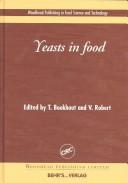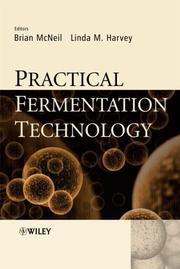| Listing 1 - 10 of 63 | << page >> |
Sort by
|

ISBN: 185573706X 9781855737068 1845698487 0849319269 9781845698485 Year: 2003 Publisher: Cambridge, England ; Boca Raton, Florida : Woodhead Publishing Limited : CRC Press,
Abstract | Keywords | Export | Availability | Bookmark
 Loading...
Loading...Choose an application
- Reference Manager
- EndNote
- RefWorks (Direct export to RefWorks)
Yeasts play a crucial role in the sensory quality of a wide range of foods. They can also be a major cause of food spoilage. Maximising their benefits whilst minimising their detrimental effects requires a thorough understanding of their complex characteristics and how these can best be manipulated by food processors.Yeasts in food begins by describing the enormous range of yeasts together with methods for detection, identification and analysis. It then discusses spoilage yeasts, methods of control and stress responses to food preservation techniques. Against this background, the bulk
Yeast. --- Leavening agents. --- Food contamination. --- Contaminated food --- Food --- Foods, Contaminated --- Contamination (Technology) --- Food adulteration and inspection --- Cooking --- Fermentation --- Nematospora --- Yeasts --- Edible fungi --- Leavening agents --- Yeast-free diet --- Contamination
Book
ISBN: 0444634088 0080999530 9780080999531 9780444634085 Year: 2017 Publisher: Amsterdam: Elsevier,
Abstract | Keywords | Export | Availability | Bookmark
 Loading...
Loading...Choose an application
- Reference Manager
- EndNote
- RefWorks (Direct export to RefWorks)
The successful structure of the previous edition of Principles of Fermentation Technology has been retained in this third edition, which covers the key component parts of a fermentation process including growth kinetics, strain isolation and improvement, inocula development, fermentation media, fermenter design and operation, product recovery, and the environmental impact of processes. This accurate and accessible third edition recognizes the increased importance of animal cell culture, the impact of the post-genomics era on applied science and the huge contribution that heterologous protein production now makes to the success of the pharmaceutical industry. This title is ideally suited for both newcomers to the industry and established workers as it provides essential and fundamental information on fermentation in a methodical, logical fashion. Stanbury, Whitaker and Hall have integrated the biological and engineering aspects of fermentation to make the content accessible to members of both disciplines with a focus on the practical application of theory. This text collates all the fermentation fundamentals into one concise reference, making it a valuable resource for fermentation scientists, as well as those studying in the field.
Fermentation. --- Fermentation --- Ferments --- Biochemical engineering --- Chemistry --- Industrial microbiology --- Microbiological synthesis --- Leavening agents
Book
ISBN: 1789853141 1789853133 Year: 2020 Publisher: London : IntechOpen,
Abstract | Keywords | Export | Availability | Bookmark
 Loading...
Loading...Choose an application
- Reference Manager
- EndNote
- RefWorks (Direct export to RefWorks)
In recent years, there has been an increase in the concern of society and industries about how food and beverages are produced, the production of natural compounds as well as the concern of industries on fermentation-based processes. Thus, there are several approaches worldwide that are looking for low time and low cost fermentation-based processes integrating not only molecular biology procedures but also engineering. This book contains eleven chapters written by international experts in the field of fermentation. It covers all recent aspects on fermentation-based processes with potential applications in many fields such as bio combustible production, food and beverage processing, and biomedicine.
Fermentation. --- Ferments --- Biochemical engineering --- Chemistry --- Industrial microbiology --- Microbiological synthesis --- Leavening agents
Book
ISBN: 025209963X 9780252099632 9780252041082 0252041089 9780252082597 0252082591 Year: 2017 Publisher: Urbana, Chicago, Springfield, [Illinois] : University of Illinois Press,
Abstract | Keywords | Export | Availability | Bookmark
 Loading...
Loading...Choose an application
- Reference Manager
- EndNote
- RefWorks (Direct export to RefWorks)
First patented in 1856, baking powder sparked a classic American struggle for business supremacy. For nearly a century, brands battled to win loyal consumers for the new leavening miracle, transforming American commerce and advertising even as they touched off a chemical revolution in the world's kitchens. Linda Civitello chronicles the titanic struggle that reshaped America's diet and rewrote its recipes.
Baking powder --- Powder, Baking --- Leavening agents --- History. --- Economic aspects --- History --- Economic aspects&delete& --- E-books
Book
ISBN: 1839688173 1839688165 Year: 2021 Publisher: London, England : IntechOpen,
Abstract | Keywords | Export | Availability | Bookmark
 Loading...
Loading...Choose an application
- Reference Manager
- EndNote
- RefWorks (Direct export to RefWorks)
Fermentation. --- Ferments --- Biochemical engineering --- Chemistry --- Industrial microbiology --- Microbiological synthesis --- Leavening agents

ISBN: 9780470014349 Year: 2008 Publisher: Chichester John Wiley & Sons
Abstract | Keywords | Export | Availability | Bookmark
 Loading...
Loading...Choose an application
- Reference Manager
- EndNote
- RefWorks (Direct export to RefWorks)
1 Fermentation: An Art from the Past, a Skill for the Future. 2 Fermentation Equipment Selection: Laboratory Scale Bioreactor Design Considerations. 3 Equipping a Research Scale Fermentation Laboratory for Production of Membrane Proteins. 4 Modes of Fermenter Operation. 5 The Design and Preparation of Media for Bioprocesses. 6 Preservation of Cultures for Fermentation Processes. 7 Modelling the Kinetics of Biological Activity in Fermentation Systems. 8 Scale Up and Scale Down of Fermentation Processes. 9 On-line, In-situ, Measurements within Fermenters.
fermentatie --- biotechnologie --- Biotechnology --- Fermentatie --- Technische microbiologie --- Technische microbiologie. --- Fermentation --- Ferments --- Biochemical engineering --- Chemistry --- Industrial microbiology --- Microbiological synthesis --- Leavening agents --- bioreactoren
Book
ISBN: 9535129287 9535129279 9535154672 Year: 2017 Publisher: IntechOpen
Abstract | Keywords | Export | Availability | Bookmark
 Loading...
Loading...Choose an application
- Reference Manager
- EndNote
- RefWorks (Direct export to RefWorks)
Fermentation is a theme widely useful for food, feed and biofuel production. Indeed each of these areas, food industry, animal nutrition and energy production, has considerable presence in the global market. Fermentation process also has relevant applications on medical and pharmaceutical areas, such as antibiotics production. The present book, Fermentation Processes, reflects that wide value of fermentation in related areas. It holds a total of 14 chapters over diverse areas of fermentation research.
Fermentation. --- Ferments --- Biochemical engineering --- Chemistry --- Industrial microbiology --- Microbiological synthesis --- Leavening agents --- Life Sciences --- Food Technology --- Agricultural and Biological Sciences --- Bromatology
Periodical
ISSN: 21864012 Year: 1988 Publisher: Tōkyō : Nihon Jōzō Kyōkai : Jōzō Gakkai,
Abstract | Keywords | Export | Availability | Bookmark
 Loading...
Loading...Choose an application
- Reference Manager
- EndNote
- RefWorks (Direct export to RefWorks)
Brewing --- Fermentation --- Brewing. --- Fermentation. --- Brassage --- Ferments --- Biochemical engineering --- Chemistry --- Industrial microbiology --- Microbiological synthesis --- Leavening agents --- Beer --- Liquors
Book
ISBN: 953513678X 9535136771 9535145746 Year: 2017 Publisher: IntechOpen
Abstract | Keywords | Export | Availability | Bookmark
 Loading...
Loading...Choose an application
- Reference Manager
- EndNote
- RefWorks (Direct export to RefWorks)
Yeast-based biotechnology traditionally regards the empirical production of fermented drinks and leavened bread, processes which surprisingly keep posing challenges and fuelling research. But yeasts nowadays also provide amenable cell factories, producing bulk and fine chemicals and molecules, and are increasingly used as tools in processes as diverse as food preservation or bioremediation. Importantly, yeasts are excellent models of cell and molecular biology for higher eukaryotes, including humans, contributing with key discoveries to understand processes and diseases. All taken, yeast-related business is worth billions, critically contributing to the economical welfare of many differently developed countries. This book provides some insights into aspects of yeast science and biotechnology less frequently addressed in the literature but nonetheless decisive to improve knowledge and, accordingly, boost up yeast-based innovation.
Yeast. --- Nematospora --- Yeasts --- Edible fungi --- Leavening agents --- Yeast-free diet --- Life Sciences --- Food Technology --- Agricultural and Biological Sciences --- Bromatology
Book
ISBN: 9535136003 9535135996 9535146149 Year: 2017 Publisher: IntechOpen
Abstract | Keywords | Export | Availability | Bookmark
 Loading...
Loading...Choose an application
- Reference Manager
- EndNote
- RefWorks (Direct export to RefWorks)
Yeast - Industrial Applications is a book that covers applications and utilities of yeasts in food, chemical, energy, and environmental industries collected in 12 chapters. The use of yeasts in the production of metabolites, enzymatic applications, fermented foods, microorganism controls, bioethanol production, and bioremediation of contaminated environments is covered showing results, methodologies, and processes and describing the specific role of yeasts in them. The traditional yeast Saccharomyces cerevisiae is complemented in many applications with the use of less known non-Saccharomyces yeasts that now are being used extensively in industry. This book compiles the experience and know-how of researchers and professors from international universities and research centers.
Yeast. --- Nematospora --- Yeasts --- Edible fungi --- Leavening agents --- Yeast-free diet --- Life Sciences --- Food Technology --- Agricultural and Biological Sciences --- Bromatology
| Listing 1 - 10 of 63 | << page >> |
Sort by
|

 Search
Search Feedback
Feedback About UniCat
About UniCat  Help
Help News
News